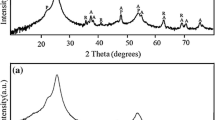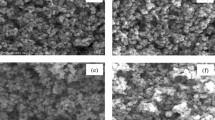Abstract
Flexible dye-sensitized solar cells (FDSSCs) have promoted interest in plastic industries as they are lightweight, flexible, and mechanically robust to accelerate production and reduce cost. However, the plastic substrates have temperature limitations in producing the TiO2 photoanode and degrade the performance of FDSSC. The main reason for this degradation is the low charge transfer in the photoanode layer. Although there is plenty of research on low-temperature fabrication methods, they indirectly increase the operational cost. Therefore, a new approach is necessary for charge transfer improvement without affecting the temperature in a low-cost platform. In this study, we present a photoanode that improves the charge transfer by doping nickel (Ni) in the TiO2 layer. A low amount of Ni doping (15%) exhibited Rct >> Rt, indicating a high charge transport and low electron recombination rate (120.84 s−1). On the other hand, higher amount Ni doping (>> 45%) has Rct << Rt which deteriorates the performance of the cell by causing severe agglomeration issues, indicating a high electron recombination rate (369.75 s−1). Moreover, the high charge transfer in (TiO2)85-Ni15-based FDSSC facilitates the electron lifetime of the cell up to 8.28 ms. Therefore, an optimum doping of Ni in TiO2-based FDSSC is studied in this work.








Similar content being viewed by others
References
Qazi A, Hussain F, ABD. Rahim N, Hardaker G, Alghazzawi D, Shaban K, Haruna K, (2019) Towards sustainable energy: a systematic review of renewable energy sources, technologies, and public opinions. IEEE Access 7:63837–63851. https://doi.org/10.1109/ACCESS.2019.2906402
Gong J, Li C, Wasielewski MR (2019) Advances in solar energy conversion. Chem Soc Rev 48(7):1862–1864. https://doi.org/10.1039/C9CS90020A
O’Regan B, Gratzel M (1991) A low-cost, high-efficiency solar cell based on dye-sensitized colloidal TiO2 films. Nature 353:737–740. https://doi.org/10.1038/353737a0
Tan WW, Yin X, Zhou X, Zhang J, Xiao X, Lin Y (2009) Electrophoretic deposition of nanocrystalline TiO2 films on Ti substrates for use in flexible dye-sensitized solar cells. Electrochim Acta 54:4467–4472. https://doi.org/10.1016/j.electacta.2009.03.037
Li G, Sheng L, Li T, Hu J, Li P, Wang K (2019) Engineering flexible dye-sensitized solar cells for portable electronics. Sol Energy 177:80–98. https://doi.org/10.1016/j.solener.2018.11.017
Li G, Wang H, Wang M, Liu W, Ardhi REA, Zou D, Lee JK (2018) Study on a stretchable, fiber-shaped, and TiO2 nanowire array-based dye-sensitized solar cell with electrochemical impedance spectroscopy method. Electrochim Acta 267:34–40. https://doi.org/10.1016/j.electacta.2018.02.075
Chang H, Hsu CM, Kao PK, Yang YJ, Hsu CC, Cheng IC, Chen JZ (2014) Dye-sensitized solar cells with nanoporous TiO2 photoanodes sintered by N2 and air atmospheric pressure plasma jets with/without air-quenching. J Power Sources 251:215–221. https://doi.org/10.1016/j.jpowsour.2013.11.051
Heinz V, Toepfl S, Knorr D (2003) Impact of temperature on lethality and energy efficiency of apple juice pasteurization by pulsed electric fields treatment. Innov Food Sci Emerg 4:167–175. https://doi.org/10.1016/S1466-8564(03)00017-1
Weerasinghe HC, Huang F, Cheng YB (2013) Fabrication of flexible dye sensitized solar cells on plastic substrates. Nano Energy 2:174–189. https://doi.org/10.1016/j.nanoen.2012.10.004
Mahalingam S, Abdullah H, Manap A (2018) Role of acid-treated CNTs in chemical and electrochemical impedance study of dye-sensitised solar cell. Electrochim Acta 264:275–283. https://doi.org/10.1016/j.electacta.2018.01.138
Chou TP, Zhang Q, Russo B, Fryxell GE, Cao G (2007) Titania particle size effect on the overall performance of dye-sensitized solar cells. J Phys Chem C 111:6296–6302. https://doi.org/10.1021/jp068939f
Benko G, Kallionien J, Myllperkio P, Trif F, Tommola JEIK, Yartsev AP, Sundström V (2004) Interligand electron transfer determines triplet excited state electron injection in RuN3-sensitized TiO2 films. J Phys Chem B 108:2862–2867. https://doi.org/10.1021/jp036778z
Chen D, Huang F, Bing CY, Caruso RA (2009) Mesoporous anatase TiO2 beads with high surface areas and controllable pore sizes: a superior candidate for high-performance dye-sensitized solar cells. Adv Mater 21:2206–2210. https://doi.org/10.1002/adma.200802603
Weerasinghe HC, Sirimanne PM, Simon YB, Cheng YB (2009) Fabrication of efficient solar cells on plastic substrates using binder-free ball milled titania slurries. Photochem and Photobiol a-Chem 206:64–70. https://doi.org/10.1016/j.jphotochem.2009.05.013
Grinis L, Kotlyar S, Puhle S, Grinblat J, Zaban A (2010) Conformal nano-sized inorganic coatings on mesoporous TiO2 films for low-temperature dye-sensitized solar cell fabrication. Adv Funct Mater 20(2):282–288. https://doi.org/10.1002/adfm.200901717
Uchida S, Tomiha M, Takizawa MK (2004) Flexible dye-sensitized solar cells by 28 GHz microwave irradiation. Photochem and Photobiol a-Chem 164(1–3):93–96. https://doi.org/10.1016/j.jphotochem.2004.01.026
Jellinek MH, Fankuchen I (1945) X-ray diffraction examination of gamma alumina. Ind Eng Chem 37:158–163. https://doi.org/10.1021/ie50422a012
Sachs M, Pastor E, Kafizas A, Durrant JR (2016) Evaluation of surface state mediated charge recombination in anatase and rutile TiO2. J Phys Chem Lett 7:3742–3746. https://doi.org/10.1021/acs.jpclett.6b01501
Ariyanto NP, Abdullah H, Ghani NSA (2009) Surface morphology characterisation of Sn-doped ZnO films for antireflective coating. Mater Res Innov 13:157–160. https://doi.org/10.1179/143307509X437491
Corkish R, Green MA, Watt ME, Wenham SR (2013) Applied photovoltaics, Earthscan, London. https://trove.nla.gov.au/work/11523836
Thirupathi S, Kaliamurthy AK, Senthilselvan J, Kathikeyan J (2018) Effect of Ni dopant in TiO2 matrix on its interfacial charge transportation and efficiency of DSSCs. J Mater Sci-Mater El 29:2228. https://doi.org/10.1007/s10854-017-8137-2
Hoshikawa T, Yamada M, Kikuchi R, Eguchi K (2005) Impedance analysis of internal resistance affecting the photoelectrochemical performance of dye-sensitized solar cells. J. Electrochem. Soc. 152:E68
Omar A, Abdullah H, Yarmo A, Shaari S, Taha MR (2013) Structural and morphology studies of zinc oxide incorporating single-walled carbon nanotubes as a nanocomposite thin film. J Phys D Appl Phys 46(165503):3603–3610. https://doi.org/10.1007/s10854-013-1291-2
Wang Q, Moser JE, Gratzel M (2005) Electrochemical impedance spectroscopic analysis of dye-sensitized solar cells. J Phys Chem B 109:14945–14953. https://doi.org/10.1021/jp052768h
Bisquert J (2002) Theory of the impedance of electron diffusion and recombination in a thin layer. J Phys Chem B 106:325–333. https://doi.org/10.1021/jp052768h
Pitarch A, Belmonte GG, Sero IM, Bisquert J (2004) Electrochemical impedance spectra for the complete equivalent circuit of diffusion and reaction under steady-state recombination current. Phys Chem Chem Phys 6:2983–2988. https://doi.org/10.1039/B401234H
Gancalves AS, Goes MS, Santiago FF, Moehl T, Davolos MR, Bisquert J, Yanagida S, Nogueiru AF, Bueno PR (2011) Doping saturation in dye-sensitized solar cells based on ZnO: ga nanostructured photoanodes. Electrochim Acta 56:6503–6509. https://doi.org/10.1016/j.electacta.2011.05.003
Mahalingam S, Abdullah H, Amin N, Manap A (2019) Incident photon-to-current efficiency of thermally treated SWCNTs-based nanocomposite for dye-sensitized solar cell. Ionics 25:747–761. https://doi.org/10.1007/s11581-018-2629-9
Mahalingam S, Abdullah H (2016) Electron transport study of indium oxide as photoanode in DSSCs: a review. Renew Sust Energ Rev 63:245–255. https://doi.org/10.1016/j.rser.2016.05.067
Wang Y, Hao Y, Cheng H, Ma J, Xu B, Li W, Cai S (1999) Photoelectrochemistry of transition metal-ion-doped TiO2 nanocrystalline electrodes and higher solar cell conversion efficiency based on Zn2+-doped TiO2 electrode. J Mater Sci 34:2773–2778. https://doi.org/10.1023/A%3A1004658629133
Jasim KE (2011) Dye sensitized solar cells-working principles, challenges and opportunities. In: Kosyachenko LA (ed) Solar cells-dye-sensitized devices. InTech, Rijeka
Acknowledgement
This work was fully supported by Universiti Kebangsaan Malaysia (Project No. GUP-2018-097 and FRGS/1/2019/STG07/UKM/02/11) and Photonic Technology Laboratory, Department of Electrical, Electronics and Systems Engineering, UKM, for the facilities.
Author information
Authors and Affiliations
Corresponding author
Additional information
Publisher's Note
Springer Nature remains neutral with regard to jurisdictional claims in published maps and institutional affiliations.
Rights and permissions
About this article
Cite this article
Abdullah, H., Mahalingam, S., Xian, K.J. et al. Impedance analysis of charge transfer upon nickel doping in Tio2-based flexible dye-sensitized solar cell. Polym. Bull. 78, 5755–5768 (2021). https://doi.org/10.1007/s00289-020-03396-w
Received:
Revised:
Accepted:
Published:
Issue Date:
DOI: https://doi.org/10.1007/s00289-020-03396-w




